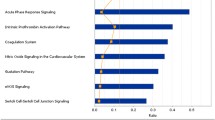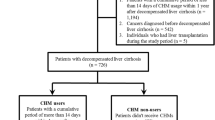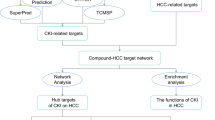Abstract
Objective
To identify specific Chinese medicines (CM) that may benefit patients with primary liver cancer (PLC), and to explore the mechanism of action of these medicines.
Methods
In this retrospective, singlecenter study, prescription information from PLC patients was used in combination with Traditional Chinese Medicine Inheritance Supports System to identify the specific core drugs. A system pharmacology approach was employed to explore the mechanism of action of these medicines.
Results
Taking CM more than 6 months was significantly associated with improved survival outcomes. In total, 77 putative targets and 116 bioactive ingredients of the core drugs were identified and included in the analysis (P<0.05). A total of 1,036 gene ontology terms were found to be enriched in PLC. A total of 75 pathways identified from Kyoto Encyclopedia of Genes and Genomes were also enriched in this disease, including fluid shear stress, interleukin-17 signaling, signaling between advanced glycan end products and their receptors, cellular senescence, tumor necrosis factor signaling, p53 signaling, cell cycle signaling, steroid hormone biosynthesis, T-helper 17 cell differentiation, and metabolism of xenobiotics by cytochrome. Docking studies suggested that the ingredients in the core drugs exert therapeutic effects in PLC by modulating c-Jun and interleukin-6.
Conclusions
Receiving CM for 6 months or more improves survival for the patients with PLC. The core drugs that really benefit for PLC patients likely regulates the tumor microenvironment and tumor itself.
Similar content being viewed by others
Data Availability Statement
The datasets generated and/or analyzed during the study are not publicly available to protect subject confidentiality but are available from the corresponding author on reasonable request.
References
Ahmed S, de Souza NN, Qiao W, Kasai M, Keem LJ, Shelat VG. Quality of life in hepatocellular carcinoma patients treated with transarterial chemoembolization. HPB Surg 2016;2016:6120143.
Jemal A, Murray T, Ward E, Samuels A, Tiwari RC, Ghafoor A, et al. Cancer statistics, 2005. CA Cancer J Clin 2005;55:10–30.
Li X, Xu X, Wang J, Yu H, Wang X, Yang H, et al. A systemlevel investigation into the mechanisms of Chinese traditional medicine: Compound Danshen Formula for cardiovascular disease treatment. PLoS One 2012;7:e43918.
Zhou W, Wu J, Zhu Y, Meng Z, Liu X, Liu S, et al. Study on the mechanisms of compound Kushen Injection for the treatment of gastric cancer based on network pharmacology. BMC Complement Med Ther 2020;20:6.
Zhu N, Hou J. Exploring the mechanism of action Xianlingubao Prescription in the treatment of osteoporosis by network pharmacology. Comput Biol Chem 2020;85:107240.
Sun JH, Sun F, Yan B, Li JY, Xin L. Data mining and systematic pharmacology to reveal the mechanisms of traditional Chinese medicine in mycoplasma pneumoniae pneumonia treatment. Biomed Pharmacother 2020;125:109900.
He LJ, Zhu XD. Analysis on regularity of prescriptions in “a guide to clinical practice with medical record” for diarrhoea based on traditional Chinese medicine inheritance support system. China J Chin Mater Med (Chin) 2016;41:2344–2349.
Dai QL, Jiang F, Wang J, Gong CL, Shi MY. Based on traditional Chinese medicine inheritance support system to analyze the regularity of umbilicus application to treat ascites due to cirrhosis. China J Chin Mater Med (Chin) 2018;43:4541–4546.
Commission CP, ed. Pharmacopoeia of the People’s Republic of China. Beijing: China Medical Science Press; 2020.
Xu HY, Zhang YQ, Liu ZM, Chen T, Lyu CY, Tang SH, et al. ETCM: an encyclopaedia of traditional Chinese medicine. Nucleic Acids Res 2019;47:D976–976, D982.
Wang D, Gu J, Zhu W, Luo F, Chen L, Xu X, et al. PDTCM: a systems pharmacology platform of traditional Chinese medicine for psoriasis. Ann Med 2017;49:652–660.
Ru J, Li P, Wang J, Zhou W, Li B, Huang C, et al. TCMSP: a database of systems pharmacology for drug discovery from herbal medicines. J Cheminform 2014;6:13.
Liu Z, Guo F, Wang Y, Li C, Zhang X, Li H, et al. BATMAN-TCM: a bioinformatics analysis tool for molecular mechanism of traditional Chinese medicine. Sci Rep 2016;6:21146.
Liu H, Wang J, Zhou W, Wang Y, Yang L. Systems approaches and polypharmacology for drug discovery from herbal medicines: an example using licorice. J Ethnopharmacol 2013;146:773–793.
Tian S, Wang J, Li Y, Li D, Xu L, Hou T. The application of in silico drug-likeness predictions in pharmaceutical research. Adv Drug Deliv Rev 2015;86:2–10.
Wishart DS, Knox C, Guo AC, Cheng D, Shrivastava S, Tzur D, et al. DrugBank: a knowledgebase for drugs, drug actions and drug targets. Nucleic Acids Res 2008;36:D901–D906.
Li J, Zhao P, Li Y, Tian Y, Wang Y. Systems pharmacology-based dissection of mechanisms of Chinese medicinal formula Bufei Yishen as an effective treatment for chronic obstructive pulmonary disease. Sci Rep 2015;5:15290.
Yan G, Wang X, Chen Z, Wu X, Pan J, Huang Y, et al. In-silico ADME studies for new drug discovery: from chemical compounds to Chinese herbal medicines. Curr Drug Metab 2017;18:535–539.
Chen CL, Tsai YS, Huang YH, Liang YJ, Sun YY, Su CW, et al. Lymphoid enhancer factor 1 contributes to hepatocellular carcinoma progression through transcriptional regulation of epithelial-mesenchymal transition regulators and stemness genes. Hepatol Commun 2018;2:1392–1407.
Huang da W, Sherman BT, Lempicki RA. Systematic and integrative analysis of large gene lists using DAVID bioinformatics resources. Nat Protoc 2009;4:44–57.
Walter W, Sánchez-Cabo F, Ricote M. GOplot: an R package for visually combining expression data with functional analysis. Bioinformatics 2015;31:2912–2914.
Berman HM, Westbrook J, Feng Z, Gilliland G, Bhat TN, Weissig H, et al. The protein data bank. Nucleic Acids Res 2000;28:235–242.
Noguchi T, Akiyama Y. PDB-REPRDB: a database of representative protein chains from the Protein Data Bank (PDB) in 2003. Nucleic Acids Res 2003;31:492–493.
Szczepankiewicz BG, Kosogof C, Nelson LT, Liu G, Liu B, Zhao H, et al. Aminopyridine-based c-Jun N-terminal kinase inhibitors with cellular activity and minimal cross-kinase activity. J Med Chem 2006;49:3563–3580.
Boulanger MJ, Chow DC, Brevnova EE, Garcia KC. Hexameric structure and assembly of the interleukin-6/IL-6 alpha-receptor/gp130 complex. Science 2003;300:2101–2104.
Shiani A, Narayanan S, Pena L, Friedman M. The role of diagnosis and treatment of underlying liver disease for the prognosis of primary liver cancer. Cancer Control 2017;24:1073274817729240.
Momin BR, Pinheiro PS, Carreira H, Li C, Weir HK. Liver cancer survival in the United States by race and stage (2001–2009): findings from the CONCORD-2 study. Cancer 2017;123Suppl 24:5059–5078.
Wang M, Ye Q, Mao D, Li H. Research progress in liver-regenerating microenvironment and DNA methylation in hepatocellular carcinoma: the role of traditional Chinese medicine. Med Sci Monit 2020;26:e920310.
Liu X, Li M, Wang X, Dang Z, Yu L, Wang X, et al. Effects of adjuvant traditional Chinese medicine therapy on long-term survival in patients with hepatocellular carcinoma. Phytomedicine 2019;62:152930.
Jain RK. Normalizing tumor microenvironment to treat cancer: bench to bedside to biomarkers. J Clin Oncol 2013;31:2205–2218.
Jain RK, Martin JD, Stylianopoulos T. The role of mechanical forces in tumor growth and therapy. Annu Rev Biomed Eng 2014;16:321–346.
Stylianopoulos T, Martin JD, Snuderl M, Mpekris F, Jain SR, Jain RK. Coevolution of solid stress and interstitial fluid pressure in tumors during progression: implications for vascular collapse. Cancer Res 2013;73:3833–3841.
Triantafillu UL, Park S, Klaassen NL, Raddatz AD, Kim Y. Fluid shear stress induces cancer stem cell-like phenotype in MCF7 breast cancer cell line without inducing epithelial to mesenchymal transition. Int J Oncol 2017;50:993–1001.
Hyler AR, Baudoin NC, Brown MS, Stremler MA, Cimini D, Davalos RV, et al. Fluid shear stress impacts ovarian cancer cell viability, subcellular organization, and promotes genomic instability. PLoS One 2018;13:e0194170.
Kolls JK, Lindén A. Interleukin-17 family members and inflammation. Immunity 2004;21:467–476.
Zhang JP, Yan J, Xu J, Pang XH, Chen MS, Li L, et al. Increased intratumoral IL-17-producing cells correlate with poor survival in hepatocellular carcinoma patients. J Hepatol 2009;50:980–989.
Kohles N, Nagel D, Jüngst D, Stieber P, Holdenrieder S. Predictive value of immunogenic cell death biomarkers HMGB1, sRAGE, and DNase in liver cancer patients receiving transarterial chemoembolization therapy. Tumour Biol 2012;33:2401–2409.
Li J, Wu PW, Zhou Y, Dai B, Zhang PF, Zhang YH, et al. Rage induces hepatocellular carcinoma proliferation and sorafenib resistance by modulating autophagy. Cell Death Dis 2018;9:225.
Palanissami G, Paul S. RAGE and its ligands: molecular interplay between glycation, inflammation, and hallmarks of cancer-a review. Horm Cancer 2018;9:295–325.
Dogra G, Chakravarti A, Kar P, Chawla YK. Polymorphism of tumor necrosis factor-α and interleukin-10 gene promoter region in chronic hepatitis C virus patients and their effect on pegylated interferon-α therapy response. Hum Immunol 2011;72:935–939.
Shi HZ, Ren P, Lu QJ, Niedrgethmnn M, Wu GY. Association between EGF, TGF-β1 and TNF-α gene polymorphisms and hepatocellular carcinoma. Asian Pac J Cancer Prev 2012;13:6217–6220.
Wang JJ, Wang ZB, Tan TC. Association of CTLA-4, TNF alpha and IL 10 polymorphisms with susceptibility to hepatocellular carcinoma. Scand J Immunol 2019;90:e12819.
Zhang M, Hu J, Li H, Zhang S, Hu W, Wu L, et al. High TNF-α and/or p38MAPK expression predicts a favourable prognosis in patients with T1N0M0 hepatocellular carcinoma: an immunohistochemical study. Oncol Lett 2019;17:4948–4956.
Levine AJ, Oren M. The first 30 years of p53: growing ever more complex. Nat Rev Cancer 2009;9:749–758.
Chen Y, Chen G, Li J, Huang YY, Li Y, Lin J, et al. Association of tumor protein p53 and ataxia-telangiectasia mutated comutation with response to immune checkpoint inhibitors and mortality in patients with non-small cell lung cancer. JAMA Netw Open 2019;2:e1911895.
Blagih J, Buck MD, Vousden KH. p53, cancer and the immune response. J Cell Sci 2020;133:jcs237453.
Acknowledgements
We thank all the participating researchers and our study staff.
Author information
Authors and Affiliations
Contributions
Zhang Z and Zeng PH contributed to the conception of this manuscript and wrote the draft; Tian XF contributed to this manuscript revision, the data collection and funding; Gao WH and Li JW helped with revision; All authors read and approved the final manuscript.
Corresponding author
Ethics declarations
The authors declare that the research was conducted in the absence of any commercial or financial relationships that could be construed as a potential conflict of interest.
Additional information
Supported by the National Natural Science Foundation of China (No. 82074450), Natural Science Foundation of Hunan Province (No. 2020JJ4066), Postgraduate Innovation Project of Hunan University of Chinese Medicine in 2020 (No. 2020CX14), “YIFANG” Postgraduate Innovation Project of Hunan University of Chinese Medicine (No. 2020YF04)
Supplementary material to
11655_2021_3449_MOESM1_ESM.pdf
Data Mining and Systems Pharmacology to Elucidate Effectiveness and Mechanisms of Chinese Medicines in Treating Primary Liver Cancer
Rights and permissions
About this article
Cite this article
Zhang, Z., Li, Jw., Zeng, Ph. et al. Data Mining and Systems Pharmacology to Elucidate Effectiveness and Mechanisms of Chinese Medicine in Treating Primary Liver Cancer. Chin. J. Integr. Med. 28, 636–643 (2022). https://doi.org/10.1007/s11655-021-3449-8
Accepted:
Published:
Issue Date:
DOI: https://doi.org/10.1007/s11655-021-3449-8




